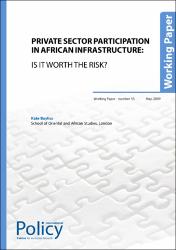Please use this identifier to cite or link to this item:
https://repositorio.ipea.gov.br/handle/11058/15580Full metadata record
| DC Field | Value | Language |
|---|---|---|
| dc.contributor.author | Bayliss, Kate | |
| dc.date.accessioned | 2024-10-04T00:00:43Z | - |
| dc.date.available | 2024-10-04T00:00:43Z | - |
| dc.date.issued | 2009 | |
| dc.identifier.uri | https://repositorio.ipea.gov.br/handle/11058/15580 | - |
| dc.description.abstract | Policies to promote privatisation in developing-country infrastructure gained momentum in the early 1990s as donors grew increasingly frustrated with efforts to strengthen public sector services that continued to fail. The strategy was intended to bring both finance and efficiency to ailing infrastructure throughout the developing world. Nearly two decades later the results have been disappointing, particularly in the areas of greatest need. The extent of investor interest in water and electricity in Sub-Saharan Africa (SSA) was massively overestimated and the hoped-for private investment failed to materialise. Rates of access to electricity and water remain far below those of other developing regions. In response to the failings of privatisation there has been a redoubling of efforts to attract investors, albeit with the recognition that this might take longer than originally thought. Privatisation in various guises is still prominent on the policy agenda. This paper critically assesses the motives behind the drive for private sector participation (PSP) in water and electricity in SSA, and reviews measures adopted by governments and donors to entice investors. In terms of restructuring and pricing, sector policies have the underlying objective of facilitating private investment and reducing the risk exposure for potential investors. In addition, a plethora of donor initiatives have emerged with the aim of bringing private investment into the region, and these too focus on reducing risk for the private sector. As a result, on offer to the private sector are the least challenging and most lucrative aspects of delivery, which are tightly ring-fenced and bound by guarantees. In industrialised economies, discussions of the merits of PSP highlight the importance of transferring risk to the private sector in order to generate efficiency gains. In contrast, as regards attracting PSP into utilities in SSA, the focus is on reducing the risk to which the private sector is exposed. But this risk is not reduced, it is transferred. As a result, African governments, taxpayers and end-users bear high levels of risk in order to accommodate the priorities of investors. (...) | en |
| dc.language.iso | en | |
| dc.title | Private Sector Participation in African Infrastructure: Is it Worth the Risk? | en |
| dc.type | Working Paper | |
| dc.rights.holder | International Policy Centre for Inclusive Growth | |
| dc.rights.holder | United Nations Development Programme | |
| dc.location.country | Brasil | |
| dc.description.physical | 54 p. : il. | |
| dc.rights.type | Licença total exclusiva | |
| dc.rights.license | O texto e dados desta publicação podem ser reproduzidos desde que as fontes sejam citadas. Reproduções com fins comerciais são proibidas. | |
| dc.subject.keyword | Private Sector | |
| dc.subject.keyword | Africa | |
| dc.subject.keyword | Infraestructure | |
| ipea.access.type | Acesso Aberto | |
| ipea.researchfields | N/A | |
| ipea.classification | Cooperação Internacional. Relações Internacionais | |
| ipea.classification | Indústria | |
| ipea.classification | Saneamento | |
| Appears in Collections: | Publicações do IPC-IG | |
Files in This Item:
| File | Description | Size | Format | |
|---|---|---|---|---|
| en_IPCWorkingPaper55.pdf | 552.3 kB | Adobe PDF |  View/Open |
Items in DSpace are protected by copyright, with all rights reserved, unless otherwise indicated.

